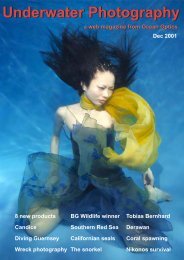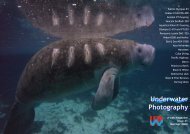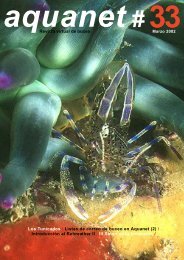Underwater Photography Underwater Photography
Underwater Photography Underwater Photography
Underwater Photography Underwater Photography
Create successful ePaper yourself
Turn your PDF publications into a flip-book with our unique Google optimized e-Paper software.
often dive a site three or four times<br />
during a trip.<br />
Whichever subject you have<br />
chosen, the most important element<br />
of the composition will normally be<br />
‘eye contact’ or at least the appearance<br />
that the subject is peering into the<br />
lens and connecting with the viewer.<br />
Some subjects seem to look interested<br />
or inquisitive whilst others may<br />
look haughty or dismissive but it is<br />
important that you have gained the<br />
attention of your subject to establish<br />
this relationship to produce a more<br />
powerful image.<br />
Fish<br />
There are numerous species of<br />
fish to target as portrait opportunities,<br />
but you will have most success<br />
with those that are territorial or are<br />
camouflage hunters or are just plain<br />
inquisitive. Many of the blenny<br />
species fall into the latter category and<br />
no matter where you are diving in the<br />
world there are going to be species of<br />
blenny that have bug eyes and often<br />
colourful markings, patterns and<br />
appendages which make them such<br />
appealing subjects.<br />
In the UK it is the tom pot<br />
blenny that takes top spot as reef<br />
poser. These comical looking little fish<br />
can be found living in the same hole<br />
in a reef for years on end. I have one<br />
www.uwpmag.com<br />
on my local beach dive site that I have<br />
been visiting and photographing for<br />
more than 5 years. He (I am making<br />
a sexist assumption here) is now so<br />
accustomed to my visits that he will<br />
immediately adopt a pose at the front<br />
on his hole when I arrive – and if the<br />
hole is vacant will generally return<br />
within a couple of minutes whilst I<br />
wait. He is so tame now that if I offer<br />
a gloved finger he will nibble it to see<br />
if there is any food on offer.<br />
These blennies have tropical<br />
cousins of course and one of the most<br />
striking is the leopard spotted blenny<br />
found in the Red Sea and in other Indo<br />
Pacific reef areas. These guys are very<br />
much more timid and are extremely<br />
difficult to spot as their pattern helps<br />
them blend with the shadows in the<br />
branching corals which is home to<br />
them. They also like the shallow<br />
elevations of the reef and are often<br />
found in 2- m depth where swell<br />
motion makes them a real challenge<br />
to photograph. Having spotted one<br />
it is then a game of patience. They<br />
normally have a route mapped out on<br />
their piece of the reef and will appear<br />
in the same spot every minute or two<br />
to take a look at you. Pre-focusing<br />
on these spots gives you the best<br />
chance of capturing them and a longer<br />
macro lens will keep you out of their<br />
personal space.<br />
Another of my shy Red Sea<br />
favourites are the lemon gobies. These<br />
Tompot blenny – A common species<br />
in the UK and Mediterranean with a<br />
very comical and expressive face which<br />
makes them an excellent macro portrait<br />
subject.<br />
(Top right) Leopoard spotted blenny<br />
– A timid and sometimes hard to find<br />
species which needs a good deal of<br />
patience to get close to for a frame<br />
filling portrait.<br />
(Right) Lemon goby – A nervous but<br />
very territorial fish found mostly on<br />
table corals often in small groups.<br />
Nikon D100, Light and Motion Titan<br />
housing, Sigma 180mm macro, Inon<br />
Quad flash, ISO200, f11 @ 1/30.<br />
40/

















